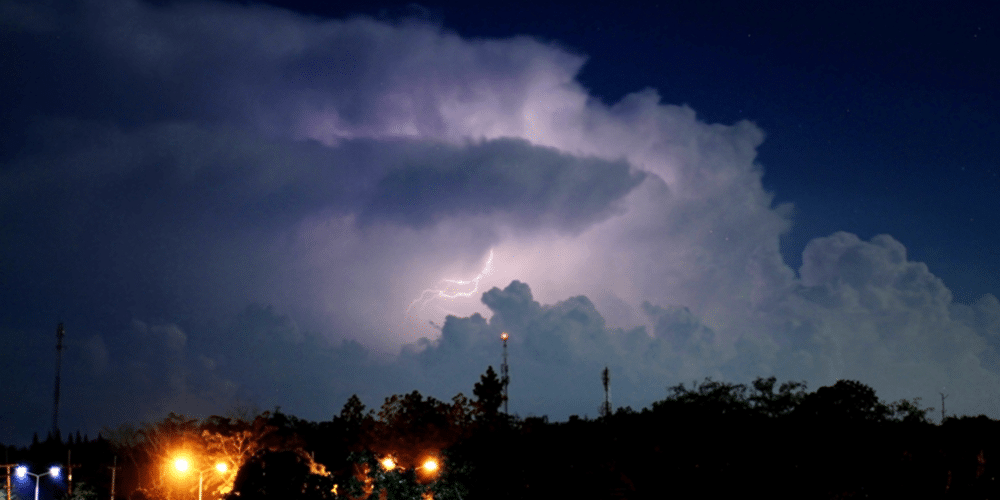If you live in the Midwest, you have likely lived through an intense storm or two–or more. Here’s how to prepare for storms in the Midwest.
The Midwest is part of the country’s Tornado Alley. Yet, it is also susceptible to other extreme weather conditions. The area’s geographical features contribute to a wide array of storm types.
The Midwest states are far from what some assume to be the moderating impacts of the Pacific and Atlantic Oceans. However, ‘moderating’ those effects may be, the Heartland is not subjected to dangerous hurricanes and seldom is subjected to earthquake devastation, raging wildfires, or mudslides.
Midwesterners, though, do tend to experience rapid temperature fluctuations. Cold arctic air often collides with tropical Gulf air, producing volatile weather systems that can produce our own extreme weather experiences.
The topography of the Great Plains is an aspect that plays a big part in our weather system. The expansive flatland terrain allows cool and hot air to interact for miles and develop into severe and robust storm systems. Then, the ‘fun’ begins.
Storm season in the Midwest ranges between April through October. In fact, May and June can produce some of the strongest and most dangerous storms in Midwest states. Tornadoes are historically more likely throughout the early months of spring and early summer. Hail and severe thunderstorms are common throughout the entire storm season.
The Heartland, along with the rest of the nation, can also experience drought and flood, windstorms, and powerful snowstorms in the winter. Yes, we get all of those, too! To summarize, the Midwest is vulnerable to damaging hailstorms, the occasional derecho or tornado, and some exciting thunderstorms.
The Science Behind the Storms
Several key factors drive the formation of a tornado and create the perfect storm.
- The collision of warm and moist air with cool and dry air.
- A strong wind pattern that creates rotation.
- Updraft and downdraft wind, which typically come along with a thunderstorm.
If these conditions are just right, they can lead to a vertical, rotating column of air – a tornado.
Types of Midwest Storms
The Midwest region of the USA is prone to a variety of intense storms throughout every season of the year. These storms can range from thunderstorms to more extreme weather events. Some of these severe storms are categorized as:
Tornadoes: Strong tornadoes are a reality living in the Midwest. There’s a reason it’s known as Tornado Alley! Tornadoes are violent windstorms that are categorized by rotating columns of air. They pose an enormous risk to property and human life.
Hailstorms: Hail often accompanies thunderstorms and can cause widespread and fast damage to vehicles and roofing and pose considerable risks to crops.
Thunderstorms: The Midwest experiences extreme thunderstorms; with them comes heavy rain, lightning, damaging winds, and hail. These severe storms frequently lead to power outages, dangerous driving conditions, and flash flooding.
Winter Storms: The Midwest frequently experiences significant winter storms that feature heavy snowfall, wind gusts, freezing rain, and sleet throughout the winter months. These types of intense storms can significantly impact traffic and travel. Severe winter weather conditions also often disrupt school schedules and bus routes.
General Storm Preparedness
Most seasoned Midwesterners know precisely what to expect throughout the severe storm season, including how to prepare. However, it is always good to have a yearly checklist to remind yourself. You definitely don’t want to be caught off guard. Preparation for extreme weather is vital to keep you, your loved ones, and your property safe.
Whenever there is an impending severe weather event, it’s a great idea to download a weather app to keep on top of the latest radar updates, just in case the storm changes paths.
Creating a Family Emergency Plan
It is imperative to have a family emergency plan in place and ensure that all family members, old and young, fully comprehend the outline of the plan.
A good family emergency plan should have a designated safe meeting spot and an outline of who is responsible for very old or young family members who might require assistance.
Every home should have an extensive disaster supply kit. It’s not just the storm itself that’s the problem; it can take days for utilities to return, which could mean you have no clean water and no power. Run through your disaster supply kit every year and make sure all items are still within their expiry date and fully functional.
The National Weather Service has a handy list published online that helps families keep up with what items should be stored in the disaster kit.
Even though cell phones are an essential part of our lives, it is crucial not to depend on them in an emergency. These electronics depend on cell towers that can be destroyed in a severe storm. All cell companies must have backup generators on site should the tower lose power. However, these gensets are typically diesel-fueled and only last a matter of days after being topped up with additional fuel. However, if roads are closed, even the emergency tower crews will not be able to reach the sites.
Home Safety Measures
Alongside having a comprehensive safety plan and safety kit, if you have time, it is also good to prepare your home and property for an extreme weather event.
If you can, reinforce any vulnerable doors and windows with wood or bring down storm shutters. Anything that might be vulnerable to being swept up in a windstorm should be securely tied down or put away so it cannot act as a form of flying debris.
Keep all vital documentation in waterproof bags to protect them from water and storm wind damage. This could include government IDs, passports, house deeds, legal documents, and certifications. Basically, anything that might be inconvenient or costly to replace. Similarly, it is also wise to keep some cash, in small bills, stored close by. When the power goes down, all POS (point of sale) devices will not function.
Although costly, purchasing a generator can be a lifesaver throughout a severe weather event. Although these generators can be expensive, they can keep food from spoiling and allow your home to function throughout the event.
Evacuation Plans
Alongside having a shelter-in-place location, it is always wise to have an evacuation plan in mind if it comes to it. Prepare several different plans depending on how you can exit the area safely. These might include paths to a friend’s or family member’s house, where you could find safer shelter during damaging winds.
When evacuating, ensure you have all vital items from your home, as you never know how long it will take for utilities to return and for life to return to normal after high winds or dangerous nighttime tornadoes.
Be Prepared and Stay Safe
Storms are a part of life in the Midwest, which is why it is so important to be prepared. Midwesterners are strong, smart, and resilient, and ready to face the wind gusts, severe weather, and storms that come our way.
Related Articles
- How to Prepare Your Home for a Natural Disaster
- Why People Are Moving to the Midwest
- 10 Best Places to Live in the Midwest
- Heroes in Our Own Backyards: Midwest First Responders
- 9 Places that Capture Minnesota’s Natural Beauty
- 10 Reasons Why Fall in the Midwest is Awesome
###


